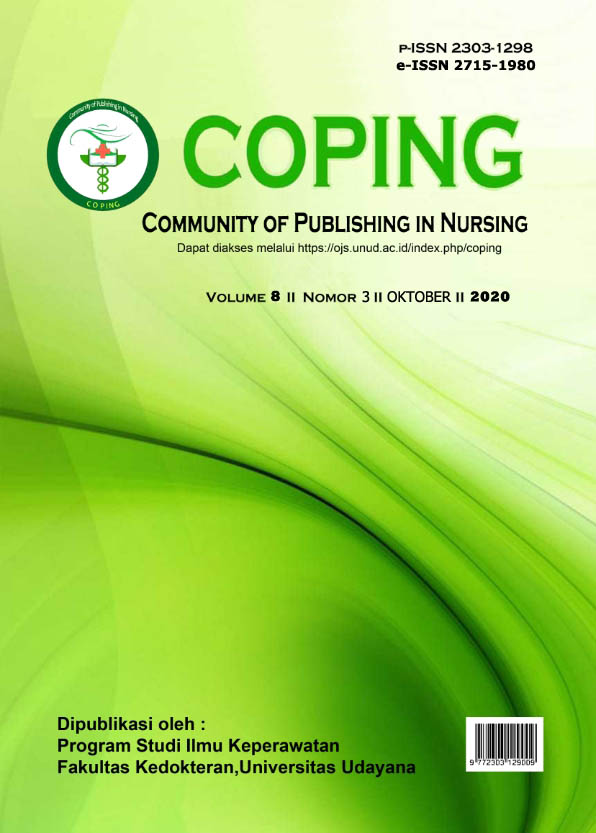HUBUNGAN DISMENORE PRIMER DENGAN PRESTASI BELAJAR MAHASISWI PROGRAM STUDI ILMU KOMUNIKASI FISIP UNUD
Abstract
Most young women experience primary dysmenorrhea. The primary dysmenorrhea affect activity especially learning. Disrupted learning activities will affect women's learning achievement. The purpose of this study was to determine the relationship between primary dysmenorrhea and the learning achievement of Communication Study Program students FISIP Unud. The design of the research is a correlative analytics through a cross sectional approach with retrospective data collection. Respondents were 65 female students of 2016-2018 who experienced primary dysmenorrhea??. The sampling used the proportionate stratified random sampling. Analysis used are frequency tables for univariate and Gamma Correlation test for bivariates (? = 0,05). Data obtained results from 65 female students who experienced primary dysmenorrhea had the most moderate dysmenorrhea as many as 37 female students (56.9%) and at most received the title of learning achievement with praise of 57 students (87.7%). The Gamma Correlation test results show that p <0.05 (p = 0.001) and the correlation value (r) = -1,000. Based on this, it can be concluded that there was a relationship between primary dysmenorrhea and the learning achievement of Communication Study Program students FISIP Unud, with a negative relationship direction that is the higher the primary dysmenorrhea, the lower the learning achievement and vice versa with the power of correlation was statistically very strong. It is expected that students will be able to choose the right effort to improve learning achievement.
Downloads
References
Aisyah, S. (2015). Perkembangan peserta didik & bimbingan belajar. Edisi 1 cetakan 1. Yogyakarta: Deepublish. Diunduh dari https://books.google.co.id/ (Diakses pada 10 Februari 2019).
Ameade, E. P. K., Amalba, A., & Mohammed, B. S. (2018). Prevalence of dysmenorrhea among university students in Northern Ghana; Its impact and management strategies. BMC Women’s Health. Diunduh dari https://www.researchgate.net/ (Diakses pada 20 Oktober 2018).
Angelia, L. M., Sitorus, R. J., & Etrawati, F. (2017). Model prediksi kejadian dismenore primer pada siswi SMA Negeri di Palembang. Jurnal Ilmu Kesehatan Masyarakat. Diunduh dari http://jikm.unsri.ac.id/ (Diakses pada 20 Oktober 2018).
Aprilyadi, N., Feri, H. J., & Ridawati, I. D. (2018). Efektifitas hypnotherapi terhadap penurunan nyeri dismenorea pada siswi SMA. Jurnal Perawat Indonesia. Vol. 2. No. 1. Diunduh dari https://journal.ppnijateng.org/ (Diakses pada 22 Juni 2019).
Bernardi, M., Lazzeri, L., Perelli, F., Reis, F. M., & Petraglia, F. (2017). Dysmenorrhea and related disorders. Diunduh dari https://www.ncbi.nlm.nih.gov/ (Diakses pada 29 Mei 2019).
Bulahari, S. N., Korah, H. B., & Lontaan, A. (2015). Faktor-faktor yang memengaruhi pengetahuan remaja tentang kesehatan reproduksi. Jurnal Ilmiah Bidan. Vol. 3, No. 2. Diunduh dari https://www.neliti.com/id/ (Diakses pada 20 Oktober 2018).
Derseh, B. T., Afessa, N., Temesgen, M., Semayat, Y. W., Kassaye, M., Sieru, S., Gizachew, S. & Ketsela, K. (2017). Prevalence of dysmenorrhea and its effect on school performance: A cross sectional study. Journal of Women’s Health Care Vol.6. Diunduh dari https://www.omicsonline.org/ (Diakses pada 19 Oktober 2018).
Fajarini, Y. I., Nurdianti, D. S., & Padmawati, R. S. (2018). Prestasi belajar pada remaja yang mengalami dismenore primer. Jurnal Kesehatan Reproduksi. Vol. 5. No. 1. Diunduh dari https://jurnal.ugm.ac.id/ (Diakses pada 08 Februari 2019).
Fillingim, R. B. (2017). Individual differences in pain: understanding the mosaic that makes pain personal. Diunduh dari https://www.ncbi.nlm.nih.gov/ (Diakses pada 29 Mei 2019).
Gebeyehu, M. B., Mekuria, A. B., Tefera, Y. G., Andarge, D. A., Debay, Y. B., Bejiga, B. S., & Gebresillassie, B. M. (2017). Prevalence, impact, and management practice of dysmenorrhea among University of Gondar students, Northwestern Ethiopia: A cross-sectional study. International Journal of Reproductive Medicine. Diunduh dari https://www.ncbi.nlm.nih.gov/ (Diakses pada 20 Oktober 2018).
Hailemeskel, S., Demissie, A., & Assefa, N. (2016). Primary dysmenorrhea magnitude, associated risk factors, and its effect on academic performance: Evidence from female university students in Ethiopia. International Journal of Women’s Health. Diunduh dari https://www.ncbi.nlm.nih.gov/ (Diakses pada 22 Juni 2019).
Hastuti, W. (2015). Perbedaan ilmu alam dan ilmu sosial. Kompasiana. Diunduh dari https://www.kompasiana.com/ (Diakses pada 18 September 2018).
Kpolovie, P. J., Joe, A. I., & Okoto, T. (2014). Academic achievement prediction: role of interest in learning and attitude towards school. International Journal of Humanities Social Sciences and Education. Vol. 1, Issue 11. Diunduh dari https://www.arcjournals.org/ (Diakses pada 20 Oktober 2018).
Putri, S. A., Yunus, M., & Fanani, E. (2017). Hubungan antara nyeri haid (dismenore) terhadap aktivitas belajar pada siswi kelas XI SMA Negeri 52 Jakarta. Universitas Negeri Malang. Diunduh dari http://journal.um.ac.id/ (Diakses pada 16 September 2018).
Reeder, M., & Koniak, G. (2011). Keperawatan maternitas kesehatan wanita, bayi dan keluarga. Eds. 18, Vol. 1. Jakarta: Penerbit Buku Kedokteran EGC.
Santi, D. R. & Pribadi, E. T. (2018). Kondisi gangguan menstruasi pada pasien yang berkunjung di Klinik Pratama UIN Sunan Ampel. Journal of Health Science and Prevention. Vol 2(1). Diunduh dari jurnalfpk.uinsby.ac.id/ (Diakses pada 07 Oktober 2018).
Septiyaningsih, S. (2017). Pengaruh aktivitas belajar dan kemandirian belajar terhadap prestasi belajar mahasiswa. Jurnal Pendidikan Dan Ekonomi. Vol. 6. No. 3. Diunduh dari http://journal.student.uny.ac.id/ (Diakses pada 08 Februari 2019).
Shaleh, A. Q. (2017). Buah hati: Antara perhiasan dan ujian keimanan. Buku Elektronik. Yogyakarta : Diandra Kreatif. Diunduh dari https://books.google.co.id/ (Diakses pada 18 Oktober 2018).
Silvanus, Mudayatiningsih, S., & Rahayu, W. (2017). Hubungan regulasi emosi dengan intensitas nyeri dismenore primer pada remaja putri di SMAN 7 Malang. Nursing News. Vol. 2, No. 3. Diunduh dari https://publikasi.unitri.ac.id/ (Diakses pada 03 Mei 2019).
Slameto. (2010). Belajar dan faktor-faktor yang memengaruhinya. Edisi Revisi. Jakarta : PT. Rineka Cipta.
Sumartini, Hasnah, Risnah, & Syisnawati. (2018). Hubungan dysmenorrhea dengan prestasi belajar mahasiswi jurusan keperawatan. Journal of Islamic Nursing. Vol. 3, No. 1. Diunduh dari https://journal.uin-alauddin.ac.id/ (Diakses pada 03 Mei 2019).
Sutawinata, A. A. & Primayanti, D. A. I. D. (2017). Hubungan kebiasaan olahraga aerobik terhadap dismenore primer pada mahasiswi 18-24 tahun Fakultas Kedokteran Universitas Udayana. E-Jurnal Medika. Vol. 6, No. 12. Diunduh dari https://ojs.unud.ac.id/ (Diakses pada 22 Juni 2019).
Yesuf, T. A., Eshete, N. A., & Sisay, N. A. (2018). Dysmenorrhea among university health science students, Northern Ethiopia: Impact and associated factors. International Journal of Reproductive Medicine. Diunduh dari https://www.hindawi.com/ (Diakses pada 20 Oktober 2018).







